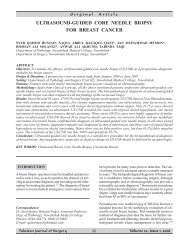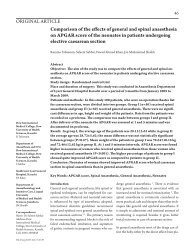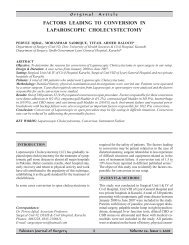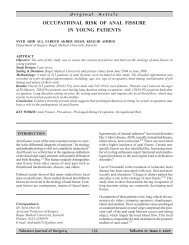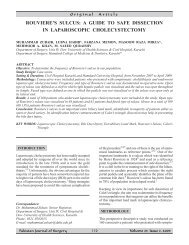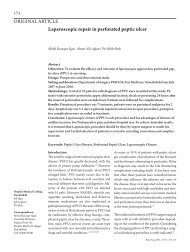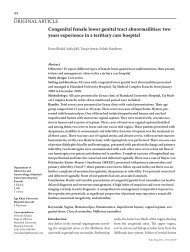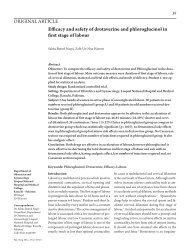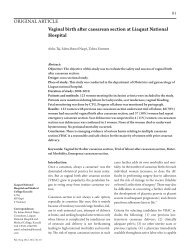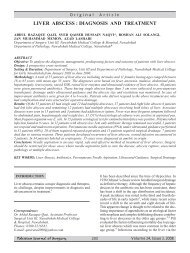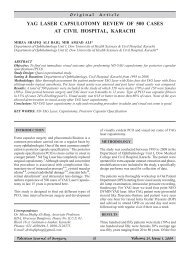rationale for near total thyroidectomy in patients with multinodular ...
rationale for near total thyroidectomy in patients with multinodular ...
rationale for near total thyroidectomy in patients with multinodular ...
- No tags were found...
You also want an ePaper? Increase the reach of your titles
YUMPU automatically turns print PDFs into web optimized ePapers that Google loves.
Rationale <strong>for</strong> Near Total ThyroidectomyJPMC. Cl<strong>in</strong>ical workup and <strong>in</strong>vestigations <strong>in</strong>clud<strong>in</strong>gthyroid function tests and thyroid scans were carriedout <strong>in</strong> all these cases; 502 <strong>patients</strong> were euthyroid whilethe rema<strong>in</strong><strong>in</strong>g 19 had mildly <strong>in</strong>creased T 4levels, andwere stabilized. Of the present<strong>in</strong>g symptoms, swell<strong>in</strong>g<strong>in</strong> front of the neck was the chief compla<strong>in</strong>t <strong>in</strong> all thecases followed by symptoms of hyperthyroidism, pa<strong>in</strong>and difficulty <strong>in</strong> swallow<strong>in</strong>g.All the <strong>patients</strong> underwent <strong>near</strong> <strong>total</strong> <strong>thyroidectomy</strong>,<strong>with</strong> preservation of the recurrent laryngeal nerves andparathyroid glands. The maximum post-operative hospitalstay was 48 hours and no post-operative complicationwas recorded. Histopathology of the excised specimenwas received <strong>in</strong> 20 days, and further management <strong>in</strong>the <strong>for</strong>m of either completion <strong>thyroidectomy</strong> or radioiod<strong>in</strong>eablation was carried out <strong>with</strong><strong>in</strong> a month, after an<strong>in</strong><strong>for</strong>med and written consent from patient.RESULTSOf the 521 <strong>patients</strong> who underwent Near <strong>total</strong> Thyroidectomy,73 (14%) were found to have a carc<strong>in</strong>oma on histopathologicalexam<strong>in</strong>ation of the removed glands. Itwas papillary carc<strong>in</strong>oma <strong>in</strong> 60 cases, follicular <strong>in</strong> eightand undifferentiated carc<strong>in</strong>oma <strong>in</strong> five cases.Out of the 73 <strong>patients</strong>, 47 (64%) underwent completion<strong>thyroidectomy</strong>. In these <strong>patients</strong>, dissection was carriedout on one side only and there was no s<strong>in</strong>gle case ofdamage to RLN or parathyroid glands. Vocal cords mobilitywas checked dur<strong>in</strong>g extubation. Post-operativehospital stay was 48 hours on an average <strong>in</strong> these cases,three days be<strong>in</strong>g the maximum. These <strong>patients</strong> werefollowed <strong>in</strong> the Outpatient Dept. and their serum calciumlevels post-operatively were <strong>in</strong> the range of 8-10 mg/dl.Twenty two <strong>patients</strong>, out of the 73, went <strong>for</strong> radioiod<strong>in</strong>eablation, which was given <strong>in</strong> a low dose due to the smallbulk of the residual thyroid tissue; consequently littletoxicity, if any, occurred. The rema<strong>in</strong><strong>in</strong>g four <strong>patients</strong>refused any further treatment.DISCUSSIONTraditionally <strong>patients</strong> <strong>with</strong> MNG have been consideredless at risk of malignancy than those <strong>with</strong> s<strong>in</strong>gle nodule.However, published reports show that the <strong>in</strong>cidence ofmalignant tumors <strong>in</strong> <strong>patients</strong> <strong>with</strong> s<strong>in</strong>gle nodule doesnot differ much from those <strong>with</strong> MNG 6,9 . MNG is arisk factor <strong>for</strong> epidemiologically ascerta<strong>in</strong>ed TC 1 . Infact,the <strong>in</strong>duction of TC follow<strong>in</strong>g a diet lack<strong>in</strong>g <strong>in</strong> Iod<strong>in</strong>ewas demonstrated <strong>in</strong> mice and a confirmation is givenby the reduction of the mortality rate <strong>for</strong> TC registered<strong>in</strong> Switzerland follow<strong>in</strong>g the supplement of iod<strong>in</strong>e <strong>in</strong>M. N. Baloch, T. Aslam, M. Maherthe table salt 10 . Epidemiological studies have demonstratedthat the <strong>in</strong>cidence of carc<strong>in</strong>oma <strong>in</strong> <strong>patients</strong> <strong>with</strong>MNG is higher than that of the <strong>in</strong>cidence <strong>in</strong> the generalpopulation 11,12 .In our retrospective analysis of 521 <strong>patients</strong> operated<strong>for</strong> MNG, 14% were found to have a carc<strong>in</strong>oma on def<strong>in</strong>itivehistopathological exam<strong>in</strong>ation. This <strong>in</strong>cidence isnot significantly different from the risk of malignancy<strong>in</strong> solitary nodules 6,9 . Adoption of a more radical procedure<strong>in</strong> solitary nodule is justified by the risk of malignancy<strong>in</strong> it. Our study showed no significant difference<strong>in</strong> this risk <strong>in</strong> MNG. Hence a more radical procedure isjustified <strong>in</strong> MNG as well.Damage to the RLN is the most feared complicationwhile operat<strong>in</strong>g on the thyroid gland. Its complicationmay vary from simple neuropraxia to death. Conserv<strong>in</strong>ga nerve is more likely when operat<strong>in</strong>g on a gland thathas not been previously explored.Adoption of a radical procedure <strong>in</strong> the first <strong>in</strong>stance letsthe surgeon identify and preserve the nerve on bothsides so that when a completion <strong>thyroidectomy</strong> is to betaken, only one side will need to be explored. Even ifan <strong>in</strong>advertent damage occurs to the nerve, that will beunilateral only. Same is the case <strong>with</strong> parathyroids andtheir preservation can prevent the need of life long calciumreplacement <strong>in</strong> <strong>patients</strong>.CONCLUSIONThe risk of malignancy <strong>in</strong> MNG should not be underestimated, and the dom<strong>in</strong>ant nodule <strong>in</strong> MNG should beregarded as a solitary nodule <strong>in</strong> an otherwise normalgland so that a more radical procedure could be adopted.Our results suggest that <strong>near</strong> <strong>total</strong> <strong>thyroidectomy</strong> <strong>with</strong>m<strong>in</strong>imal residual tissue is a versatile surgical procedure<strong>for</strong> <strong>patients</strong> <strong>with</strong> mult<strong>in</strong>odular goitre <strong>with</strong> low risk ofcomplications.REFERENCES1. Franceschi S. Epidemiologia del Carc<strong>in</strong>oma dellaTiroide. In: Miani P, ed. Carc<strong>in</strong>oma della Tiroide.Pisa: Pac<strong>in</strong>i Editore; 1992. p.13-29.2. Miani P, Piemonte M, Bacchi G, Miani C. Fattoriprognostici e risultati terapeutici nel Carc<strong>in</strong>omadella Tiroide. In: Miani P, ed. Carc<strong>in</strong>oma della Tiroide.Pisa: Pac<strong>in</strong>i Editore; 1992. p.167-97.3. Cole WH. Incidence of Carc<strong>in</strong>oma of the Thyroidgland <strong>in</strong> nodular goiter. Sem<strong>in</strong> Surg Oncol 1991;7(2): 61-3.178Volume 23, Issue 3, 2007



